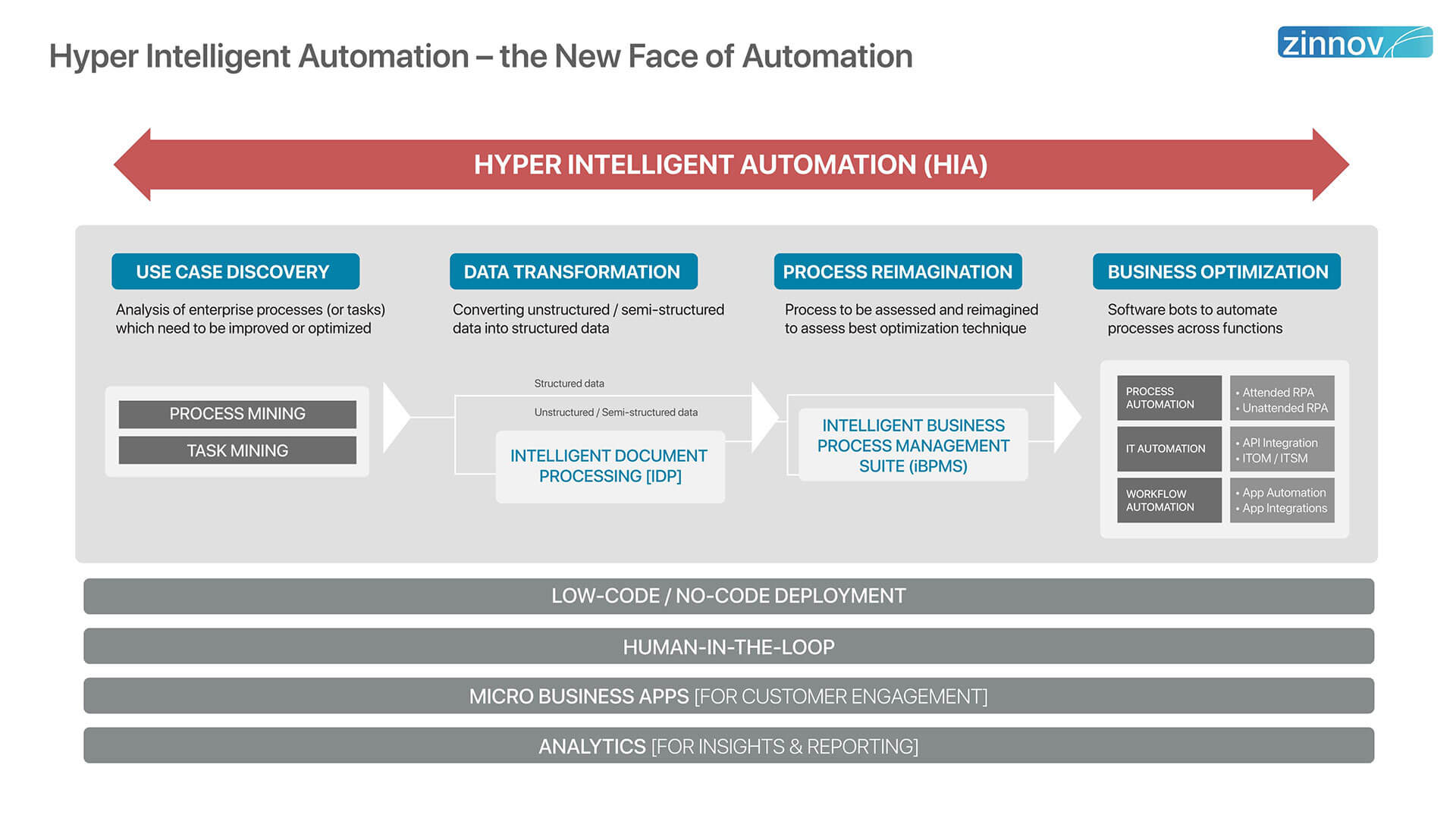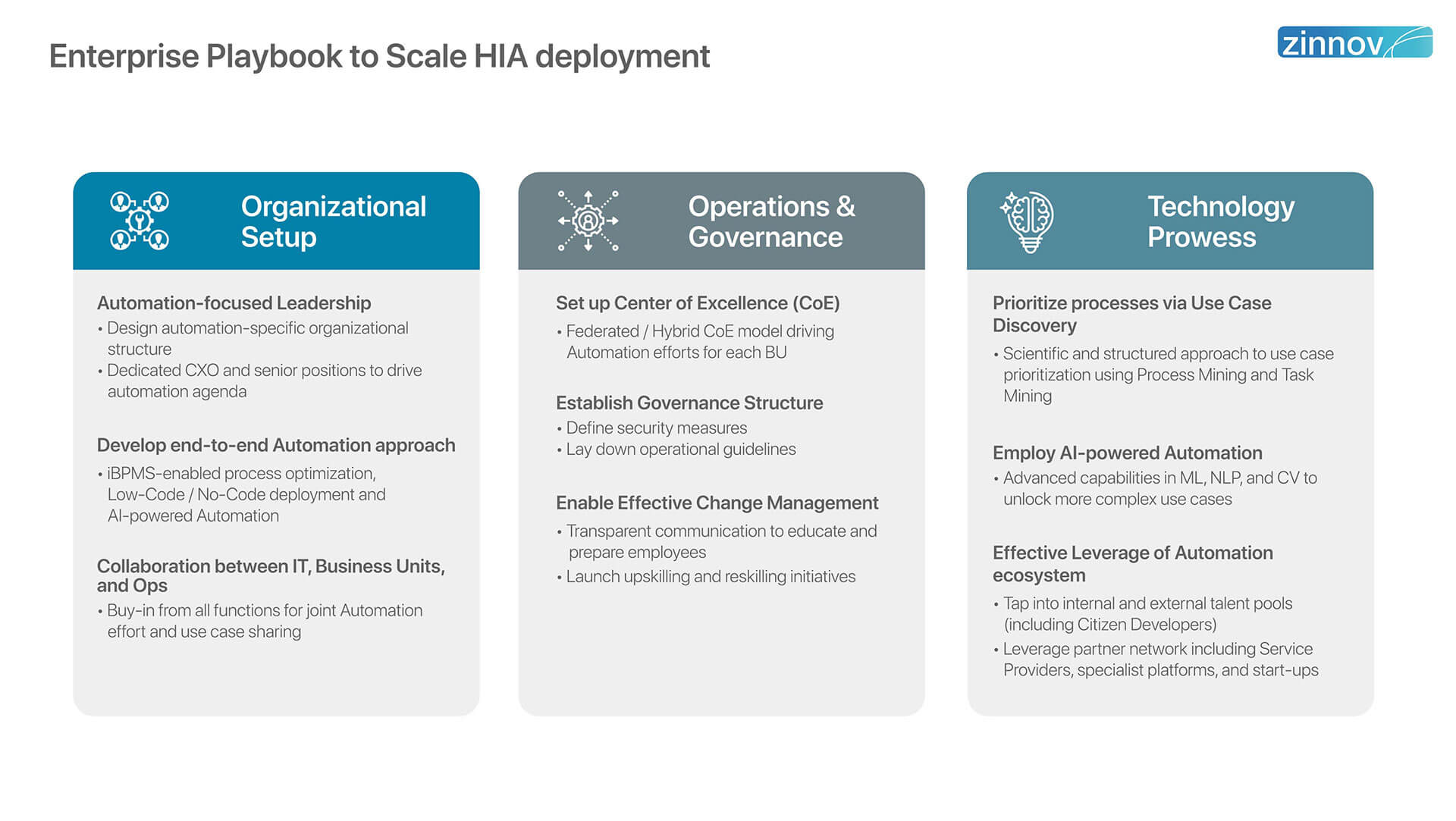Zinnov has been on a relentless mission to demystify automation, which has been on a rapid reinvention journey and morphed into a holistic, end-to-end avatar – Hyper Intelligent Automation (or HIA). The prominence of automation cannot be overemphasized under modern business environments, as the operational setbacks induced by COVID-19 have only strengthened the case for automation. This has catapulted automation right to the top of CIO (Chief Information Officer) priorities.
As we continue to explore the key trends that define the automation landscape, we are excited to be partnering with the leading automation platform UiPath, the recently crowned decacorn. The joint report by Zinnov and UiPath, “Hyper Intelligent Automation Landscape – 2020,” is a comprehensive view on the critical role of automation within the enterprise growth story and how modern-day platforms are responding to this ever-increasing demand for Hyper Intelligent Automation.
Automation today, has evolved into Hyper Intelligent Automation (or HIA) in order to drive frictionless customer experiences and compelling outcomes. HIA has four basic building blocks, with RPA at its core and Use Case Discovery, Intelligent Document Processing (IDP), and Business Process Management (iBPMS) as its other building blocks.

Value-conscious enterprises start their automation programs with Use Case Discovery, where the enterprises are adopting a scientific approach of process mining and task mining to identify the best use case candidates for automation. The use cases are then prepared for automation by leveraging Intelligent Document Processing (IDP) to convert unstructured (or semi-structured) data into structured data. This is followed by iBPMS reimagining the processes for optimization. And finally, automation forms the final building block of Hyper Intelligent Automation which includes automation of business processes, IT processes, and/or workflows.
With automation cementing its place as a top technology priority, the total addressable market (TAM) for Hyper Intelligent Automation stands at a staggering USD 65 Bn, globally. Enterprises have spent more than USD 4.7 Bn already by mid-2020, and we expect a massive growth of 55% in the next five years, to reach more than USD 40 Bn by 2025. This growth is forecasted despite the setback caused by the ongoing COVID-19 pandemic.
In fact, it has been fascinating to witness how automation has been right at the forefront in the battle against COVID-19. All the leading automation/RPA platforms stepped up and came up with new innovative use cases to support the fight against the pandemic. Automation has helped enterprises across industries ensure business continuity and resilience. And in fact, automation has helped enterprises go beyond resilience to be antifragile in the COVID times. We are currently tracking more than 50 such COVID-relevant use cases.
There are several unique advantages offered by automation which make it both compelling and effective during the ongoing pandemic. Automation promises a fast deployment; enterprises can have use cases up and running in 48–72 hours flat. The other unique advantage is around remote deployments and remote POCs, since the use cases can be completely on Cloud or mobile. Additionally, automation is non-invasive and independent of the current systems, which makes them easy to deploy and scale. And finally, automation is scalable; so if the pandemic exacerbates, then the bots can be ramped up to take the additional load easily. Hence, automation is being aptly positioned as the technology for pandemic-proofing enterprises.
While there had already been a huge enterprise demand and uptake for HIA before COVID-19 hit, the business case for automation has become even more compelling during the ongoing crisis.
We have been talking to a lot of enterprises across industries on their automation focus areas and investments. In addition, we also conducted a comprehensive analysis of the leading Fortune 250 (F250) enterprises to gather details around their depth of automation use cases, automation talent, strategy areas, industry partnerships, and other investments such as centers of excellence (CoE), etc. It is interesting to see that 75% of these F250 enterprises (or ~190 enterprises) have already made significant investments in Hyper Intelligent Automation.
Our analysis revealed that enterprises from Banking, Financial Services, Insurance, Retail, and Healthcare are the leading industries that account for almost 2/3rd of the global automation investments. For instance, BNY Mellon has deployed over 1000 bots to automate crucial processes such as trade clearing, order research, data reconciliation, etc., which has helped it achieve 88% improvement in processing time. Similarly, Morgan Stanley accelerated its digital transformation focus a few years back by announcing a massive investment of USD 500 Mn towards Process Automation, Analytics, and Mobile Technology. IT Process Automation was also one of the core focus areas within their transformation plan. Other industries such as Telecom, Travel & Hospitality, and Public Sector are also ramping up focus on automation-led use cases. For instance, AT&T has close to 1000 bots handling the end-to-end execution of several processes including tracking complaint tickets, generating invoices, data entry, etc. Effectively, close to 50% of all administrative tasks have been automated across these enterprises.
Hence, there is immense demand for deploying automation initiatives from leading enterprises. However, at the same time, enterprises continue to struggle to scale their automation deployments. Our analysis shows that only 15% of the F250 enterprises have been able to scale to more than 100 bots as of now. In fact, more than 1/3rd of these enterprises are currently deploying 10 or fewer bots, and struggling to scale. There are several reasons for these scaling-related challenges. Deriving tangible value and requisite ROI from the automation deployments is among the major challenges that enterprise deployments are facing. The deployment cycles for automation are very long, due to which enterprises fail to derive the requisite ROI. To add to this, there is immense confusion and lack of clear accountability among IT, business, and operations teams, leading to unwarranted resistance in sharing use cases. Another key challenge is the inability to automate a greater proportion of the use cases due to unstructured data which needs to be converted into a structured format before being automated.
We spoke to CXOs and senior stakeholders in the Fortune enterprises, automation platforms, and the services ecosystem to devise the Playbook that enterprises can leverage to scale their automation deployments. Below are the three broad pillars of this playbook. Enterprises need a structured process in place which spans the three prongs of focused organizational setup, operations and governance structure, and up-leveling their technology prowess in order to reap the fruits of scaled automation deployments.

On one hand, there is immense demand for automation initiatives from the leading enterprises, and this in turn presents a huge opportunity on the supply side as well. What’s interesting is that the HIA space is today contested by more than 500 platforms spread across the different building blocks of HIA as highlighted in the HIA framework image. There are three key trends of Democratization – Platformization – Ecosystem Building that emerge in our analysis of these platforms within the automation space.
While the RPA platforms started the automation revolution, over the years, the industry has witnessed several new entities that have entered the space. Technology giants are the most interesting among them, with Microsoft acquiring Softomotive earlier in May 2020, and more recently, IBM acquiring WDG Automation – all testaments to the fact that technology giants who were hitherto on the sidelines, have now gone all in with massive investments in automation. Low Code/No Code platforms have also ramped up focus on automation – whether it was the no code platform Nintex which acquired Enablesoft RPA in 2019, or Appian acquiring Jidoka earlier this year. We expect further consolidation in this space, with newer players entering the mix.
There is immense convergence across the different building blocks of HIA, and all the leading automation platforms are vying to become a “platform of platforms” to have an integrated platform narrative. Among the Big 3 platforms, UiPath is following a hybrid approach of Build, Acquire, and/or Partner for capabilities across the HIA building blocks.
Platforms are leveraging the ecosystem – led by governments, academic institutions, and Service Providers – to further scale their automation initiatives. Automation platforms worked closely with government and public sector agencies to ensure business continuity during COVID-19 – for both internal processes as well as to provide citizen services. Deep partnerships with academic institutes have remained a key focus in order to inculcate the automation philosophy at the very grassroots level of education. Finally, platforms continue to work closely with their Service Provider or partner network – spanning large System Integrators (SIs), mid-tier niche SIs, BPO providers, and management consulting firms (including the Big 4).
Platforms continue to focus deeply on these three areas in order to emerge on top in the automation marathon.
Hyper Intelligent Automation has rapidly emerged as an exponential technology, and is at the top of the boardroom agenda today. In fact, the automation narrative has become even more compelling in the wake of the ongoing crisis, having helped enterprises not only weather the storm, but also emerge stronger on the other side by being antifragile. In a recent keynote, Satya Nadella opined that Microsoft has seen 2 years’ worth of Digital Transformation in a matter of 2 months because of COVID-19. And this trend is expected to continue even as we begin to come out of the crisis. There is clearly immense action and traction within the automation space, and the supply side ecosystem has consequently put requisite mechanisms in place to proactively cater to this increased demand. The Hyper Intelligent Automation (HIA) space is clearly on the trajectory to explode in the foreseeable future, and we are surely in for exciting times ahead.